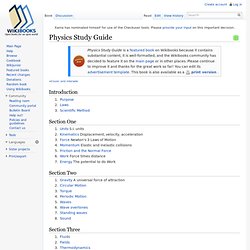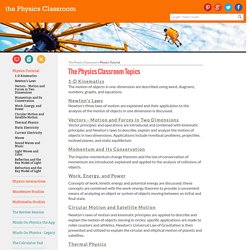

Www.curriki.org/nroc/Introductory_Physics_1/ Learn AP Physics - AP Physics B. Video lesson on Motion in One Dimension (external link) Your email address will not be shared.

See our Terms of Service for more info on how your privacy is protected. You'll receive a new AP Physics-style multiple-choice problem delivered to your email inbox each weekday. Click on the link in the email to see the solution. This non-calculus, college-level physics curriculum includes Newtonian mechanics, thermodynamics, waves, sound, optics, electricity, magnetism, atomic physics, nuclear physics, and relativity. While there are distinct advantages to learning--either in a classroom or online--with a real physics teacher, there are a number of online references that can help supplement your instruction.
Links to Online Video Lessons AP Lessons from the Monterey Institute for Technology & EducationMIT OpenCourseWare AP PhysicsThe Mechanical Universe and Beyond (requires free registration, or see individual lesson links below) Video Lessons & Problems, Organized by Unit. FHSST Physics. The Free High School Science Texts: A Textbook for High School Students Studying Physics.

Units[edit] Waves and Wavelike Motion[edit] Vectors[edit] Forces[edit] Rectilinear Motion[edit] Momentum[edit] Work and Energy[edit] Collisions and Explosions[edit] Newtonian Gravitation[edit] Pressure[edit] Important Equations and Quantities Heat and Properties of Matter[edit] Motion Mountain - The Free Physics Textbook for Download. Physics Study Guide. Xania has nominated himself for use of the Checkuser tools.

Please provide your input on this important decision. From Wikibooks, open books for an open world <Cover and interwiki Introduction Section One Units S.I. unitsKinematics Displacement, velocity, accelerationForce Newton's 3 Laws of MotionMomentum Elastic and inelastic collisionsFriction and the Normal ForceWork Force times distanceEnergy The potential to do Work Section Two Section Three FluidsFieldsThermodynamicsElectricity Charge, current, electric fieldsMagnetism Magnetic dipoles, magnetic fieldsElectronics Resistance, voltage, capacitance, inductance (incomplete)Optics Light, lasers etcTheories of Electricity Theories behind Electricity Appendices.
The Physics Classroom Topics. 1-D Kinematics The motion of objects in one-dimension are described using word, diagrams, numbers, graphs, and equations.

Newton's Laws Newton's three laws of motion are explained and their application to the analysis of the motion of objects in one dimension is discussed. Vectors - Motion and Forces in Two Dimensions Vector principles and operations are introduced and combined with kinematic principles and Newton's laws to describe, explain and analyze the motion of objects in two dimensions. Momentum and Its Conservation The impulse-momentum change theorem and the law of conservation of momentum are introduced, explained and applied to the analysis of collisions of objects. Work, Energy, and Power Concepts of work, kinetic energy and potential energy are discussed; these concepts are combined with the work-energy theorem to provide a convenient means of analyzing an object or system of objects moving between an initial and final state.